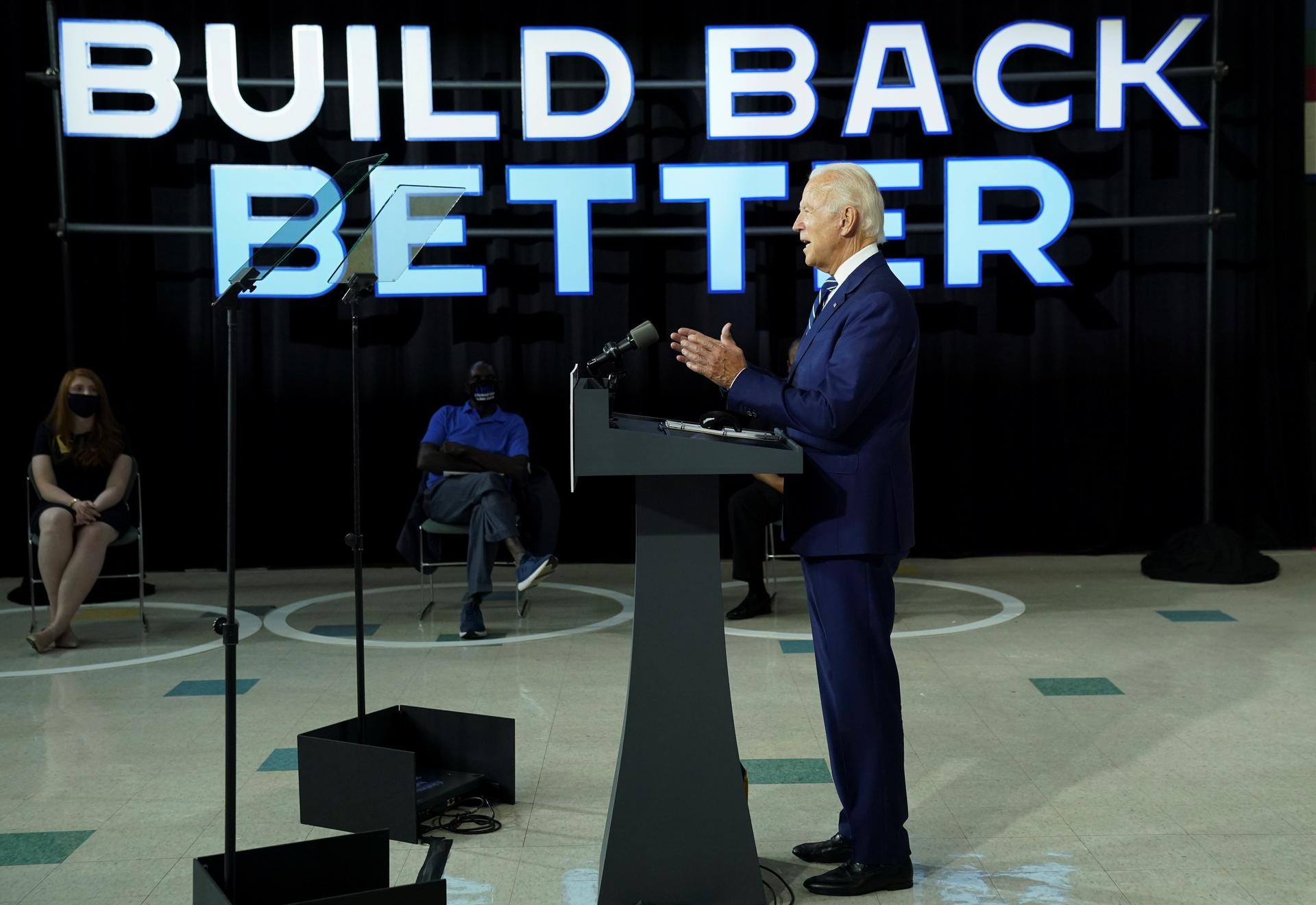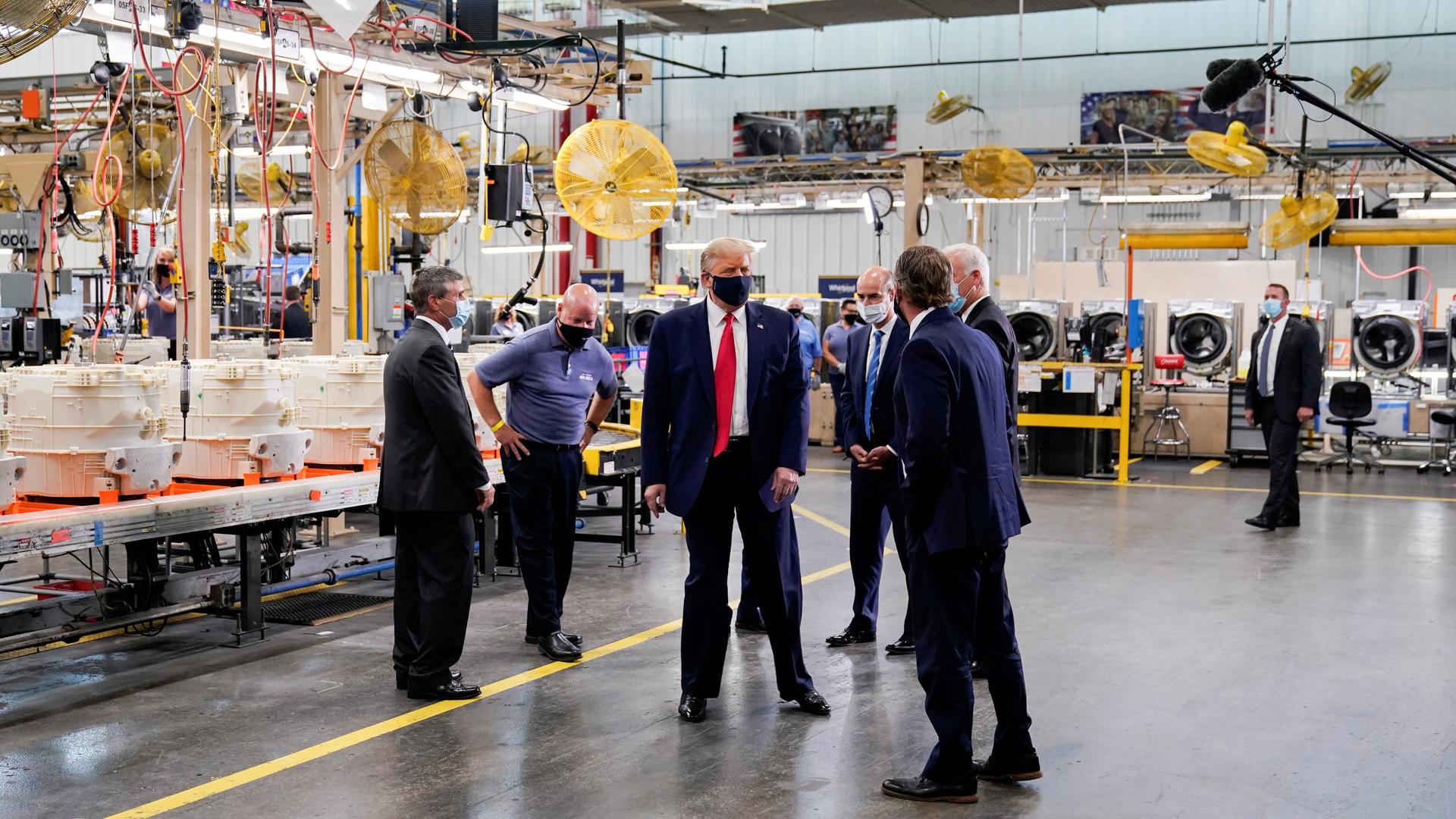Explainer: American voters never forget — it’s the economy, stupid
In the run-up to the general election on Nov. 3, our series examines how US President Donald Trump and Democratic challenger Joe Biden diverge on key issues by identifying important stories that highlight what the candidates would do differently on the global stage:
For much of the current presidential election cycle, US voters consistently said that they trusted Donald Trump to do a better job handling the economy than his Democratic challenger, Joe Biden. Moreover, those who prioritized the economy over other issues — such as the coronavirus, foreign policy or health care — were more likely to support the Republican incumbent.
However, the tables have turned, and Biden has attracted many swing voters in battleground states who worry about the impact of the coronavirus-induced recession on their pocketbooks. While pandemic lockdowns and public health restrictions are hitting many industries hard, consumers’ fears are having the biggest impact on languishing sectors such as hospitality, travel, tourism and entertainment.
We examine the economic challenges ahead, plus the stubbornly high unemployment rate, stalled stimulus proposals, rival tax policies and contrasting trade plans:
Ailing economy
When 2020 began, the economy was exceptionally strong, and conventional wisdom suggested that a second Trump term in the White House was all but guaranteed. He took office with an already robust set of indicators until this year — overseeing a triad of impressive numbers: joblessness at a 50-year low of 3.5%, Wall Street extending the longest bull market ever, and gross domestic product growth posting decent figures quarter after quarter.
But that all imploded in the spring, with the US hemorrhaging jobs, businesses closing their doors and investors panicking. In some voter surveys, the economy is now picked as the most important issue, with one-third of respondents saying it is their top factor in deciding who to back on Nov. 3.
To be sure, both Trump and Biden argue that restoring the economy is crucial for the next president to succeed. But their strategies differ significantly.
Related: The economics of a global emergency
Much of Trump’s election sales pitch hinges on his economic record — before the pandemic struck. Biden, on the other hand, wants to seize the opportunity to remake an already unequal economy, reviving a society ravaged by a silent enemy that took advantage of preexisting weaknesses across racial, class and socioeconomic lines. Although many voters recognize Trump’s economic accomplishments during the first three years of his presidency, they’re increasingly skeptical that he is the right candidate to restore prosperity.
And while Americans patiently look for improvements in the economy’s V-shaped recovery, many experts credit the Federal Reserve’s monetary policy before and after the pandemic for maintaining the low interest rates that have sustained consumer lending and business activity.
Jobless rate
Along with the economy as a whole, jobs have been fitfully coming back. But a comprehensive recovery remains far off — for Americans as well as many others in countries that have struggled to mitigate the spread of COVID-19. In the US, the GDP plunged almost 33% in the second quarter.
The peak fraction of unemployed Americans approached 15% in April before heading back down toward 8% last month. And staggering numbers of jobless claims propelled the economy to a worse state than during the Great Recession, a level more comparable to the depths of the Great Depression of the 1930s.
Under the “Build Back Better” banner, Biden’s campaign website states, “Make no mistake: America has been knocked down. … Millions have lost jobs, hours, pay, health care, or the small business they started, through no fault of their own.”

Moody’s Analytics forecasted that a Biden administration and Democratic Congress would be best for job recovery. And UBS analysts wrote in a note published earlier in October: “Investors may have initially feared a Blue Wave, but a delayed or contested election outcome is even more unsettling.”
Biden pledges a “comeback package for Main Street businesses and entrepreneurs,” while Trump promises 10 million new jobs in the first 10 months of his second term — ostensibly by further lowering corporate taxes and cutting regulations. Meanwhile, political observers say Trump’s platform doesn’t even include an economic plan for a second term.
Raising corporate taxes, high-earner income taxes and additional deficit spending, Biden says, could promote good union jobs through ambitious climate and infrastructure projects. The former vice president would aim to pass a $15 minimum wage and invest in predominantly minority neighborhoods. He would also increase government funding for college tuition.
Stimulating economic growth
Trump signed about $3 trillion in stimulus measures during the initial months of the coronavirus crisis. However, negotiations to add another $2 trillion of relief funding remain stalled in Congress. A bipartisan deal will have to wait until after Election Day.
As he was convalescing in the West Wing and overcoming his own bout with the virus, Trump oscillated wildly between a Twitter declaration that further stimulus wouldn’t imminently happen and statements urging negotiators to seal a deal for enhanced federal unemployment insurance, more direct payments to individuals, replenished funds for small businesses and money to state and local governments. But lawmakers couldn’t agree on an overall amount or the exact mix of programs.
Related: How the US coronavirus stimulus package compares to those of Europe
Just using the powers of the executive branch, Trump has had limited capacity to bypass legislative deadlock. A series of August orders deferred payroll taxes and suspended student loan payments, though more substantial relief necessitates working with Congress — regardless of who is victorious next week.
Biden’s priorities resemble the contents of the moribund $3 trillion HEROES Act that House Speaker Nancy Pelosi’s Democrats passed through the House of Representatives in May. As such, Biden favors more funds for health and nutrition programs in addition to hazard pay for front-line workers and emergency housing support. He also advocates for more funding for test-and-trace initiatives and a guarantee that all Americans can receive free COVID-19 care, saying that the economy won’t recover until the pandemic is under control.
His recovery plan revolves around four main components: mobilizing American manufacturing and innovation; building modern infrastructure and a clean energy future; creating a 21st-century caregiving and education workforce; and advancing the cause of racial equity in the US.
Tax plans
For many Republicans, Trump’s biggest first-term accomplishment is the Tax Cuts and Jobs Act of 2017, which reduced the tax burden for most personal income brackets and cut the corporate rate from 35% to 21%. That bill also repealed the Affordable Care Act’s individual mandate to obtain coverage, which Biden would seek to reinstate.

Biden has also said he will repeal the $10,000 cap on state and local tax (SALT) deductions that were imposed by the 2017 cuts — which mostly affect affluent households in higher-tax states.
Even before the financially ruinous pandemic struck, Trump’s fiscal policies pushed up the federal deficit and added substantially to the national debt. Biden argues that Trump’s tax cuts mostly benefited wealthy Americans and companies, leaving many people behind. He would undo some of the cuts, especially on households with annual income over $400,000 — but keep them in place for the middle class. The conservative-leaning American Enterprise Institute estimated that Biden’s plan would raise rates for the top 5% of households but reduce them for the bottom 95%.
Biden’s plans would use taxes to reduce carbon dioxide emissions and incentives to help lower-income families purchase homes, whereas Trump aims to expand “opportunity zones” offering tax deferrals for funds invested in underprivileged communities — a program that Democrats have scrutinized.
The candidates have starkly different views about capital gains taxes on the sale of equities and real estate. Biden would increase the top long-term rate for wealthy households from the current 23.8% to 39.6%, whereas Trump wants to reduce it significantly.
Trade relations
Soon after Trump took office, he withdrew from the Trans-Pacific Partnership and moved to replace NAFTA with the USMCA — both of which Biden originally supported.
Despite Trump’s “America first” efforts to wage trade wars, there is some overlap with policies Biden intends to implement. Both Biden and Trump have campaigned on reshoring jobs and penalizing companies that engage in offshoring.
Related: Both candidates’ platforms underline US struggle to confront China
The former Democratic senator from Delaware agrees with several aspects of the Trump administration’s China strategy, though Biden hasn’t said if he’ll scrap the current tariffs on Beijing’s exports to the US. While Biden has been critical of Trump’s tactics vis-a-vis China, he would similarly oppose any countries that engage in unfair trade practices.
From taxes and trade to job creation and stimulus measures — irrespective of who takes a seat in the Oval Office in early 2021 — the pandemic will constrain the global economic recovery for a long time to come.
The story you just read is accessible and free to all because thousands of listeners and readers contribute to our nonprofit newsroom. We go deep to bring you the human-centered international reporting that you know you can trust. To do this work and to do it well, we rely on the support of our listeners. If you appreciated our coverage this year, if there was a story that made you pause or a song that moved you, would you consider making a gift to sustain our work through 2024 and beyond?
